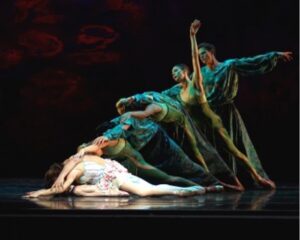Bringing the Beauty and Order of Fine Arts to Raleigh
What do basketball and professional ballet have in common? According to Ward Purrington, plenty.
“The movements are basically the same,” said Purrington, a retired lawyer from Raleigh and long-time lover of North Carolina’s arts scene. “In fact, some professional sports teams have used ballet to develop the agility and the conditioning of their professional athletes. That’s a really interesting part of ballet to me — the athleticism.”
It’s one of many factors that have contributed to Purrington’s love of classical ballet — and his crucial role in founding Carolina Ballet, a premier professional company recognized as one of the top ballets in the United States.
Carolina Ballet has grown from its humble beginnings to touring internationally and hosting many performances throughout the year.
Robert Weiss, founding artistic director for Carolina Ballet, said that ballet brings “beauty, order, harmony, and spirituality” to a world often filled with misery and ugliness. “The art when performed on the highest professional level literally takes you out of yourself and transports you to a higher plane of feeling,” he said.
A vision realized
Carolina Ballet originally was known as the Raleigh Dance Theatre, a student ballet organization founded in 1984. It eventually transformed into the pre-professional Carolina Ballet Theatre under the direction of Ann Vorus and her successor Mary LeGere.
That’s when Purrington became interested. His daughter, Lindsay, took him to see a performance of the Boston Ballet’s “Sleeping Beauty,” which inspired the Raleigh lawyer to investigate how to launch a professional dance company in North Carolina’s Triangle region of Raleigh, Durham, and Chapel Hill.
“We had a good symphony, a good art museum, and a good theatre, but we didn’t have dance represented in Raleigh,” Purrington said. “That’s when I began to work to try to attract interest.”
Carolina Ballet became a professional company when Weiss became Founding Artistic Director, bringing his wealth of ballet experience to the Triangle. Weiss has a storied career as a principal dancer and protege of George Balanchine at New York City Ballet and thereafter as Artistic Director of Pennsylvania Ballet in Philadelphia.
“A city the size of Raleigh would never have had a first class professional ballet without the vision of Ward Purrington and a few other founders, including the John William Pope Foundation,” Weiss said. “Ward’s vision that brought me here to Raleigh and the Triangle changed the arts in this region of the country. Being a part of that has changed my life as well.”
Shortly after its formation, Carolina Ballet was named “a characterful, well-disciplined and exciting company” by The New York Times. The company’s inaugural season opened in the fall of 1998.
Performances
One of Carolina Ballet’s first performances was also one of Purrington’s favorites — a chorography of George Frideric Handel’s “Messiah,” one of the most famous choral arrangements in Western Civilization. Originally the piece was performed around the Christmas holidays, but later moved to Easter, when Handel intended it to be performed.

Through its Dances in Schools program, Carolina Ballet also has brought opportunity into public schools. During school visits, dancers perform an example ballet, answer students’ questions about life in the ballet, and provide students with a chance to join in a short dance routine.
Future plans
In the coming years, Weiss hopes to expand the ballet’s national and international footprint. “We would like to grow the international reputation of the company and, at the same time, become ambassadors for Raleigh, the Triangle, and North Carolina,” he said.
For his own part, Purrington has high hopes for Carolina Ballet’s future. “Robert Weiss is a real genius. He’s used a very small amount of money to create a very, very fine ballet company. And thanks to the Pope Foundation, we have enjoyed their support for the company almost since the beginning.”
And what about basketball? In the days when he was first organizing the company professionally, Purrington said that they gauged interest in training basketball players in ballet at the University of North Carolina at Chapel Hill.
“We approached Dean Smith about that,” Purrington said. “He said that he only had so many days to teach his boys basketball. He couldn’t teach them ballet, too.”